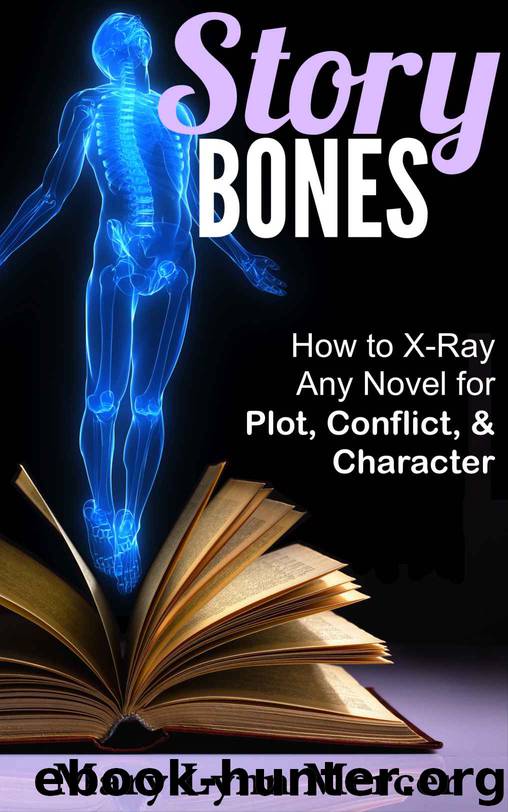Story Bones: How to X-Ray Any Novel for Plot, Conflict, and Character by Mary L. Mercer

Author:Mary L. Mercer [Mercer, Mary L.]
Language: eng
Format: azw3
Publisher: Mary L. Mercer
Published: 2013-12-21T16:00:00+00:00
Character growth is the lifeblood of stories. The protagonist may go through hell and high water, but that’s not enough to satisfy a reader. A story only feels worth the reading if the character grows and changes. It’s the protagonist’s growth that is largely responsible for individualizing universal structure patterns into unique stories.
There are three basic ways a character can change during the course of a story. Each way, when applied to the classic structure described earlier, makes the story look different. When examining book X-rays, it’s helpful to understand these three different character paths (also called “arcs”) to avoid confusion and cultivate inspiration.
In The Inner Game of Screenwriting, Sandy Frank explores the three basic character arcs most commonly used. He also details hybrids and alterations, but they all boil down to these three:
1. The character begins with a flaw that’s eroding his happiness, and because of the conflict encountered in pursuit of an external goal, changes into a better person. This is by far the most popular character arc for protagonists to make, and the one most likely to resonate with readers of genre fiction.
2. A character begins as a healthy person, but because of the conflict encountered in pursuit of an external goal, his values are refined by his fiery trials and he becomes even stronger. (Think of any John Wayne movie or long-running fiction series with a recurring central protagonist, like Earl Stanley Gardner’s Perry Mason.)
3. A character begins as a seemingly healthy person, but because of the conflict encountered in pursuit of an external goal, his values are compromised and weakened until he’s worse off than at the beginning. This one shows up a lot in literary fiction.
The same story structure “bones” come alive in totally different ways when energized by these three styles of character arcs.
In the first scenario, Act 1 shows how the character’s flaw is eroding his happiness, while the events and sequences in Act 2 push him to be a better person, until Act 3 shows the finished product of his internal change.
The second scenario shapes itself differently. Act 1 shows how the character’s values make things harder for him, while the conflicts in Act 2 do everything to push him off track and into betraying those values, until Act 3 shows him rising from the ashes hardened like steel in his convictions.
The third scenario belongs to tragedies and cautionary tales like Mario Puzo’s The Godfather and F. Scott Fitzgerald’s The Great Gatsby. Act 1 demonstrates the character’s values, while Act 2 tempts and pressures him into compromising his very soul, until in Act 3 he’s a moral shadow of the person he once was.
If the character’s growth arc is the lifeblood of the tale, then the character’s personality is the unique DNA swirling through the blood. It informs which flaws are convincing fits for which characters.
The Enneagram is an ancient personality system that defines nine levels of psychological health for each of nine different personality types (which can be further broken down into hundreds of variations).
Download
This site does not store any files on its server. We only index and link to content provided by other sites. Please contact the content providers to delete copyright contents if any and email us, we'll remove relevant links or contents immediately.
The Kite Runner by Khaled Hosseini(5082)
Gerald's Game by Stephen King(4576)
Dialogue by Robert McKee(4321)
The Perils of Being Moderately Famous by Soha Ali Khan(4169)
The 101 Dalmatians by Dodie Smith(3451)
Story: Substance, Structure, Style and the Principles of Screenwriting by Robert McKee(3397)
The Pixar Touch by David A. Price(3362)
Confessions of a Video Vixen by Karrine Steffans(3241)
How Music Works by David Byrne(3184)
Fantastic Beasts: The Crimes of Grindelwald by J. K. Rowling(2994)
Harry Potter 4 - Harry Potter and The Goblet of Fire by J.K.Rowling(2986)
Slugfest by Reed Tucker(2937)
The Mental Game of Writing: How to Overcome Obstacles, Stay Creative and Productive, and Free Your Mind for Success by James Scott Bell(2844)
4 - Harry Potter and the Goblet of Fire by J.K. Rowling(2652)
Screenplay: The Foundations of Screenwriting by Syd Field(2572)
The Complete H. P. Lovecraft Reader by H.P. Lovecraft(2514)
Scandals of Classic Hollywood: Sex, Deviance, and Drama from the Golden Age of American Cinema by Anne Helen Petersen(2464)
Wildflower by Drew Barrymore(2442)
Robin by Dave Itzkoff(2383)
